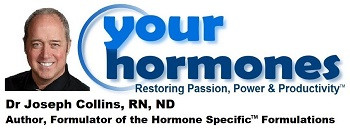
Support Healthy Estrogen Detoxification by Joseph J Collins, RN, ND
An increasing body of evidence reveals that how estrogens are metabolized in a woman’s body is one of the strongest factors determining her risk of developing cancer, as well as auto-immune disease and inflammation disorders. To increase "good" estrogens, such as 2-hydroxyestrone choose the following lifestyle and dietary changes. These can also decrease the "bad" estrogens, such as 16-alpha-hydroxyestrone, and the 4-hydroxyestrogen.
It should be noted that both men and women metabolize estrogens. Ideally, more estrogens will be metabolized through the 2-hydroxy pathway. A common way of evaluating this pathway is to measure both as 2-hydroxyestrone and 16-alpha-hydroxyestrone. The 2:16 ratio should show more 2-hydroxyestrogens.
Supporting healthy estrogen detoxification is important for both men and women.
Higher 2-hydroxyestrogens (as well as 2-methoxyestrogens- which are discussed below) have a lower risk of hormone associated cancers in both men and women.
An increasing body of evidence reveals that how estrogens are metabolized in a woman’s body is one of the strongest factors determining her risk of developing cancer, as well as auto-immune disease and inflammation disorders. To increase "good" estrogens, such as 2-hydroxyestrone choose the following lifestyle and dietary changes. These can also decrease the "bad" estrogens, such as 16-alpha-hydroxyestrone, and the 4-hydroxyestrogen.
It should be noted that both men and women metabolize estrogens. Ideally, more estrogens will be metabolized through the 2-hydroxy pathway. A common way of evaluating this pathway is to measure both as 2-hydroxyestrone and 16-alpha-hydroxyestrone. The 2:16 ratio should show more 2-hydroxyestrogens.
Supporting healthy estrogen detoxification is important for both men and women.
Higher 2-hydroxyestrogens (as well as 2-methoxyestrogens- which are discussed below) have a lower risk of hormone associated cancers in both men and women.
Your body converts indole-3-carbinol to diindolylmethane (DIM), the activated metabolite of indole-3-carbinol. DIM is also available as a dietary supplement.
If you do not consistently consume the mentioned vegetables at least 3 to 4 times a week, consider using a DIM supplement, such as DIM Enhanced, which has other herbs to also promote healthy estrogens metabolism.
Rosemary: This herb increases healthy estrogen metabolism and is able to enhance the formation of 2-hydroxyestrone - the good estrogen. It is also a great antioxidant and has even been used to help improve memory. Rosemary is also a carminative. Consider using it more often in your diet, or choose a supplement that has concentrated rosemary extract. Rosemary also helps with thyroid function and is included in ThyroMend™, Thyroid function is important for healthy estrogen detoxification, as discussed below.
Flax Seed: One to three tablespoons of ground flaxseed should be consumed each day. May increase to 1/4 cup each day further enhance 2-hydroxylation. It is very import to realize that it is the unique fibers (lignans) in the whole seed that promote healthy estrogen metabolism. While flax oil may supply simple omega-3 oils and some lignans, it is the whole ground seed, or defatted flaxseed meal, that is truly rich in lignans.
Salmon: Salmon is a good source of eicosapentaenoic acid (EPA), an omega-3 oil that is capable of increasing the formation of 2-hydroxyestrone - the "good" estrogen. It is important to realize that simple omega-3 oils (such as alpha-linolenic acid from flax), must go through a number of metabolic processes before it can become the more complex EPA that is capable of promoting health estrogen metabolism. Cold water fish such as salmon will provide EPA. If you do not eat salmon at least once a week, consider very high grade Omega-3 capsules such as QUELL Fish Oil Ultra EPA.Also consider taking high grade Omega-3 capsules as a supplement.
ISOFLAVONES - The isoflavones (such as daidzein and genistein) can enhance the formation the good estrogens by increasing 2-hydroxylation. Though these isoflavones do occur in soy, non-soy sources of these same isoflavones are found in Trifolium pratense, as well as Pueraria montana & Pueraria lobata. Consider these sources when soy is avoided because of allergies. These non-soy sources of isoflavones are included in EstroMend™ to promote healthy estrogen metabolism is that formulation.
Activated Folic Acid: Folic acid is essential for ideal hormone metabolism, DNA synthesis, homocysteine metabolism, and nervous system function. Activated folic acid assists with the conversion of good estrogens (2-hydroxyestrogens) into REALLY GOOD estrogens (2-methoxyestrogens). These 2-methoxyestrogens may actually have anti-cancer actions on cells that have transformed into cancer. The problem is, about 30 percent of humans unable to adequately convert folic acid to the activated form, 5-methyltetrahydrofolate, also called Methyl Folate. Methyl Folate is available as an individual supplement. Folic acid is essential for ideal hormone metabolism, DNA synthesis, homocysteine metabolism, and nervous system function. Make sure that other B-vitamins that work with folic acid are taken as well, such as B6 & B12. A good combination of 5-methyltetrahydrofolate, with activated B6 and the best form of B12 (methylcobalamine) is B-Complex with Metafolin.
Exercise: Exercise will also increase good estrogens by intensify the process of 2-hydroxylation. This is another reason why exercise is such an important part of a healthy lifestyle.
Proper Thyroid Function: Proper thyroid function is directly related to healthy estrogen metabolism. Low thyroid activity (hypothyroidism) may increase the amount of "bad" estrogens, even if you are making good dietary choices. Talk to your healthcare professional if you suspect decreased thyroid function. The seven key functions associated with optimal thyroid health can be supported with ThyroMend™.
Originally from: Discover Your Menopause Type (pages 325-326 & 328-329), by Dr Joseph Collins, RN, ND.
Next: Test Before & After BHRT
